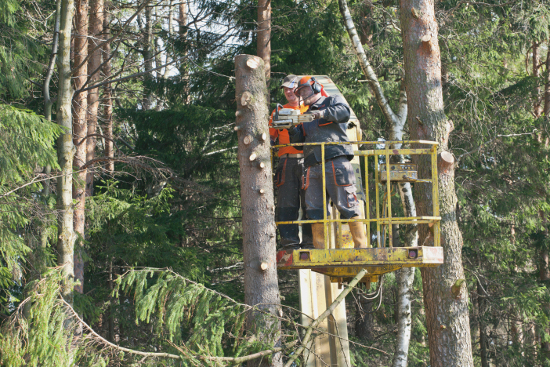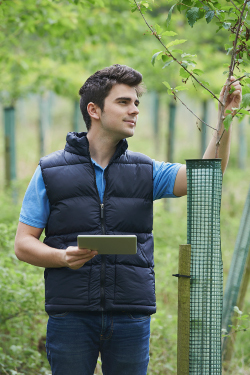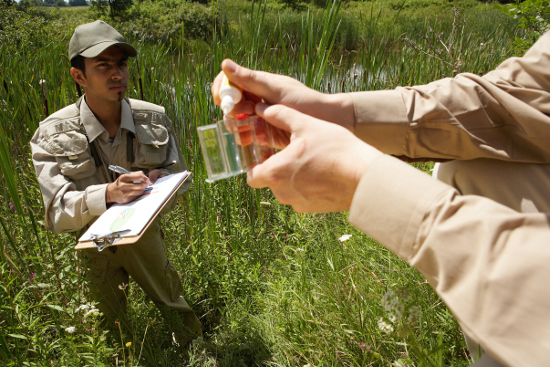An official website of the United States government
 United States Department of Labor
United States Department of Labor
| August 2016
Maybe you’d rather work under natural light than fluorescent lights, with the outdoors as your office. If so, consider a career in forestry.
Workers in forestry occupations spend a lot of time outside, maintaining and conserving parks and forest land. During the latter half of the 20th century, their emphasis was on preservation: managing the land, monitoring plants for insects and diseases, and collecting and studying forest data, among other tasks. But in recent years, understanding that forest health includes clearing excess trees and brush, these workers also may be involved in controlled burns or managing forest fires.
Keep reading to find out more about conservation scientists, foresters, forest and conservation technicians, and forest and conservation workers. You’ll learn how the occupations care for the land in different ways.

Forestry occupations focus on the healthy growth and maintenance of woodlands and parks. This may include wildland fire oversight or suppression efforts. Advances in technology allow workers to monitor these lands with precision. For example, geographic information system (GIS) maps and satellite imagery provide real-time data for measuring forest depth and growth.
Conservation scientists. These scientists manage and protect forests, parks, and natural resources. To protect the environment, they work with government agencies and private landowners on issues of land use and improvement. Conservation scientists use forest monitoring software, including remote sensing tools, to collect data for forest inventory, analyzing the quality of forest areas, and other purposes.
Foresters. Foresters oversee forest land, manage budgets, create plans for forestry projects, and supervise forest and conservation technicians and workers. In addition, foresters ensure that forest crew activities comply with government regulations.
Forest and conservation technicians. Technicians measure forest details and help with quality improvement. For example, they use tools such as GIS software to compile and analyze forest data, which then helps them determine how trees should be removed and which seedlings should be planted to enrich forest health. Technicians also may supervise some duties of forest and conservation workers.
Forest and conservation workers. Under the supervision of foresters and forest and conservation technicians, these workers maintain and protect forests. They plant and cut trees, clear debris, and spray forest vegetation with insecticides and herbicides.
Employment, wages, and job outlook vary for occupations related to forestry, according to data from the U.S. Bureau of Labor Statistics (BLS). (See table 1.)
| Occupation | Employment, May 2015 |
Median annual wage, May 2015 |
Projected change in employment, 2014–24 (percent) |
|---|---|---|---|
|
Forest and conservation technicians |
29,810 | $35,430 | -6% |
|
Conservation scientists |
20,200 | 61,110 | 7 |
|
Foresters |
8,590 | 58,230 | 8 |
|
Forest and conservation workers |
6,870 | 26,190 | 4 |
|
Source: U.S. Bureau of Labor Statistics |
|||
Employment. The Western United States employed the most forestry workers in May 2015: for example, California had the highest employment of forestry and conservation workers, forestry and conservation technicians, and foresters and the second highest employment (behind Texas) of conservation scientists.
The states with the highest concentration of forestry employment include remote areas that are covered by forest lands. For example, Montana and South Dakota had many jobs for conservation scientists and forest and conservation workers, respectively, and Idaho had a high concentration of foresters.
But, as table 1 shows, total employment in these occupations was relatively small. And employment was primarily in federal, state, and local governments. Other jobs were in private industry, such as logging. Some conservation scientists worked in social advocacy organizations.
Wages. In May 2015, median annual wages—the point at which half of workers made more than that amount, and half made less—ranged from $26,190 for forestry and conservation workers to $61,110 for conservation scientists, according to BLS. Compare these with the median annual wage of $36,200 for all occupations.

Outlook. Between 2014 and 2024, BLS projects average employment growth for foresters and conservation scientists and slower-than-average growth for forest and conservation workers. Employment of forest and conservation technicians is expected to decline.
The need for workers to control wildfires, along with increased demand for timber and wood pellets, is projected to account for employment increases. Productivity gains resulting from use of technology are expected to contribute to slowing and declining employment.
However, BLS also projects about 15,900 job openings for foresters and conservation scientists due to the need to replace workers who are retiring or leaving for other reasons.
Occupations in forestry have a similar work environment: in addition to working in offices, they require time outdoors, sometimes in remote locations. The desire to work outdoors is often a big draw for these workers.
But working in a forest is not exactly a nature hike. These jobs may require an irregular work schedule, and many of the tasks are physically demanding—and sometimes dangerous.

Positives. Forestry occupations may appeal to people who balk at the idea of spending their entire workday in an office. Part of their appeal is that many forest sites are remote and diverse in climate, flora, and fauna.
Another appealing aspect for workers in these occupations is the chance to actively take part in conserving and improving the environment. Their efforts may help to contain or prevent wildfires, for example, thereby saving plant and animal life, preserving natural habitats, and avoiding destruction of nearby property.
For some workers, such as foresters and conservation scientists, these jobs offer an opportunity to apply their knowledge using state-of-the-art equipment. For example, light detection and ranging (lidar), a survey technology tool that uses laser light to measure distance, helps conservation scientists create detailed maps of an entire forest to analyze its health.
Negatives. Despite having an idyllic setting, forestry work can be dangerous, even deadly. For example, workers in forestry occupations are exposed to all types of weather. In addition to the inconvenience and unpleasantness of working in rain, snow, and other forms of precipitation, extreme temperatures and weather conditions can create hazards—such as ice-covered roads and lightning strikes—for people who work outside.
Working outdoors regularly can be exhausting, too, both mentally and physically. Forestry workers must be comfortable with solitude, carrying heavy equipment, and dealing with forest inhabitants of all shapes and sizes—from mosquitoes to bears.
And forest fires, which have been increasing in the past 20 years in both size and intensity, pose a threat to those who fight them. Fires can rage for days, forcing workers to keep long, erratic hours until an area is safe.
Skills are related to education requirements, which vary by occupation: Forestry workers in jobs that typically require less education do more physical tasks, and those in jobs typically requiring more education often focus on analysis. Some forestry workers may receive training on the job.
Skills. Nearly all forestry workers must have critical-thinking and problemsolving abilities. They also need strong math skills, for activities such as calculating the number of seedlings to plant per acre; knowledge of sciences related to natural resources, including biology and geography; and communication skills, for making presentations, writing reports, or collaborating with colleagues.
Specific attributes and skills required may vary by occupation. For example, forest and conservation workers need physical stamina to traverse wooded areas carrying equipment. And conservation scientists must have management skills because they coordinate projects with crews of forestry workers.

Education. To enter these occupations, forest and conservation workers typically need a high school diploma; forest and conservation technicians, an associate’s degree; and conservation scientists and foresters, at least a bachelor’s degree.
Associate’s degree forestry programs usually emphasize hands-on learning and practical skills and are therefore often located in areas with abundant forest lands. Vocational forestry programs typically emphasize field studies, applied forestry software, and wildland firefighting. Other topics include botany, land surveying, and dendrology (the science of tree identification).
Programs for bachelor’s degrees include more theory, science, and project management coursework. Advanced programs, such as those for master’s or doctoral degrees, typically focus on sophisticated tools of forest measurement.
Prospective forest workers at all levels may be eligible to join professional organizations, for networking or to learn about employment opportunities. Association websites often include lists of accredited programs, organized by specialization.
Training. Entry-level conservation scientists, foresters, and forest and conservation technicians usually don’t need to be trained on the job to become competent in their occupations. Forest and conservation workers typically receive on-the-job training, often through assisting experienced workers, that lasts from 1 to 12 months. Depending on the state in which they are employed, these workers also may be required to complete training in the use of commercial pesticides.
Many forestry workers receive safety training on monitoring and suppressing forest fires. The U.S. Forest Service and many states offer programs. Minimum training typically lasts a few days and includes instruction in the nature of wildland fires, how human behavior affects a fire’s growth, and the necessity for controlled fires for overall forest health. In addition, these training programs focus on worker safety.
Learn more about conservation scientists and foresters, forest and conservation workers, and hundreds of other career options in the Occupational Outlook Handbook (OOH). The OOH describes what workers do, their pay, typical entry-level education requirements, job outlook, and more.
Other Career Outlook articles that may be of interest if you’re thinking about forestry work include:
Alan Zilberman, "Careers in forestry: Nature’s office suite," Career Outlook, U.S. Bureau of Labor Statistics, August 2016.